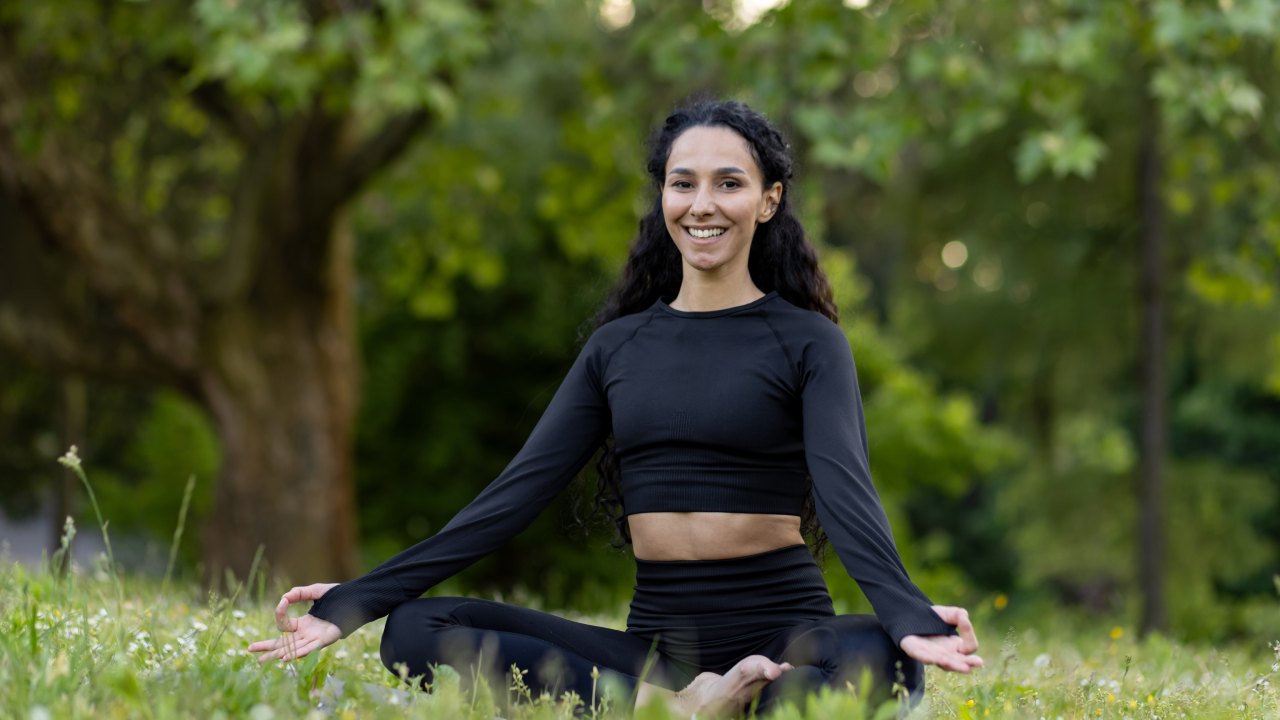Understanding the Benefits of Yoga for Mental Health
How Yoga Can Support Mental Wellbeing
We embrace yoga for its numerous benefits to mental health. Yoga, with its combination of physical postures, breath control, and meditation, can enhance mental well-being by promoting relaxation and reducing stress levels. Practicing yoga has been shown to lower cortisol levels, the primary stress hormone, which helps to reduce feelings of anxiety and depression. Additionally, regular yoga practice can improve sleep quality, increase energy levels, and enhance overall mood.
Research supports the idea that yoga can be an effective complementary treatment for various mental health conditions. For instance, a study on the impact of yoga on mental health found significant reductions in anxiety and depression symptoms after regular practice.
| Study Metrics | Baseline | After Yoga Practice |
|---|---|---|
| Anxiety Levels (out of 10) | 7.5 | 3.2 |
| Depression Levels (out of 10) | 6.8 | 2.9 |
By integrating yoga into our daily routine, we can create a strong foundation for mental well-being. For more insights on how mindfulness and meditation benefit mental health, refer to our article on the benefits of mindfulness and meditation.
The Connection Between Yoga and Mental Health
The connection between yoga and mental health is deeply rooted in its practice. Yoga engages both the body and the mind, fostering a holistic approach to mental health care. When we practice yoga, the deep breathing techniques activate the parasympathetic nervous system, which induces a state of calm and relaxation. This physiological response is essential for managing stress and anxiety.
Furthermore, the mindfulness aspect of yoga helps us stay present and become more aware of our thoughts and feelings. This awareness allows us to observe our mental patterns without judgment, leading to greater emotional regulation and resilience. Practicing grounding poses, heart-opening poses, and inversion poses can significantly enhance this sense of mental clarity and emotional balance. Explore these poses in detail in our article on practicing yoga poses for mental health.
Yoga also encourages physical movement, which is vital for mental health. Engaging in regular physical activity releases endorphins, the “feel-good” hormones that elevate mood and reduce feelings of depression. For additional approaches to managing mental health through physical activity, check out our piece on the role of physical exercise in managing anxiety and depression.
Incorporating yoga into our self-care practices can nurture the mind-body connection, ultimately leading to improved mental health. Learn more about holistic strategies, such as aromatherapy, to further enhance mental well-being.
Practicing Yoga Poses for Mental Health
Yoga offers numerous benefits for mental health, including increased relaxation, reduced stress, and enhanced emotional balance. Incorporating specific yoga poses into your routine can support your overall mental wellbeing. Here, we explore grounding poses, heart-opening poses, and inversion poses.
Grounding Poses
Grounding poses help reconnect us to the present moment and create a sense of stability and balance. These poses can be particularly beneficial for reducing anxiety and stress.
Mountain Pose (Tadasana): This foundational pose helps improve posture and develop awareness of your body in space.
Child’s Pose (Balasana): A restful pose that promotes relaxation and calms the mind.
Warrior II (Virabhadrasana II): This pose builds strength and focus, grounding both the mind and body.
| Pose Name | Benefits | Duration (Minutes) |
|---|---|---|
| Mountain Pose | Improves posture, enhances body awareness | 1-2 |
| Child’s Pose | Promotes relaxation, calms the mind | 3-5 |
| Warrior II | Builds strength, enhances focus | 1-2 per side |
Heart-Opening Poses
Heart-opening poses can foster emotional openness and combat feelings of depression and negativity. These poses allow for deeper breathing and can enhance the feeling of inner joy.
Bridge Pose (Setu Bandhasana): Widens the chest, reduces mild depression and fatigue.
Camel Pose (Ustrasana): Opens the heart center, releases tension in the body, promotes emotional balance.
Upward-Facing Dog (Urdhva Mukha Svanasana): Strengthens the spine, opens the chest, boosts mood.
| Pose Name | Benefits | Duration (Minutes) |
|---|---|---|
| Bridge Pose | Reduces mild depression, widens the chest | 1-2 |
| Camel Pose | Releases tension, promotes emotional balance | 1-2 |
| Upward-Facing Dog | Strengthens spine, boosts mood | 1-2 |
Inversion Poses
Inversion poses shift the perspective by bringing the head below the heart, increasing blood flow to the brain and relieving stress and anxiety.
Legs Up the Wall (Viparita Karani): Calms the nervous system, reduces anxiety, promotes relaxation.
Shoulder Stand (Sarvangasana): Stimulates the thyroid gland, relieves stress and mild depression.
Headstand (Sirsasana): Improves focus, increases blood flow to the brain, reduces stress.
| Pose Name | Benefits | Duration (Minutes) |
|---|---|---|
| Legs Up the Wall | Reduces anxiety, promotes relaxation | 5-10 |
| Shoulder Stand | Relieves stress, stimulates thyroid | 2-3 |
| Headstand | Improves focus, reduces stress | 1-2 |
By incorporating these yoga poses into your regimen, you can enhance your mental health and overall well-being. For additional practices that support mental health, explore our articles on the benefits of mindfulness and meditation and the therapeutic benefits of journaling.
Incorporating Breathwork and Meditation
Breathwork and meditation are integral components of yoga that provide profound mental health benefits. By integrating these practices into our yoga routine, we can enhance relaxation, reduce anxiety, and improve our overall mental wellbeing.
Mindful Breathing Techniques
Mindful breathing techniques, also known as pranayama, are essential for achieving a calm and focused mind. These techniques involve conscious control of breath to influence our mental and emotional state. Practicing mindful breathing can help lower stress levels, increase concentration, and promote relaxation.
| Technique Name | Description | Duration |
|---|---|---|
| Diaphragmatic Breathing | Deep breathing using the diaphragm | 5-10 mins |
| Box Breathing | Inhale, hold, exhale, hold (4 seconds each) | 5-10 mins |
| Alternate Nostril Breathing | Inhale and exhale through alternate nostrils | 5-10 mins |
For more information on the benefits of mindfulness and meditation, visit our article on the benefits of mindfulness and meditation.
Guided Meditation Practices
Guided meditation practices involve following the instructions of a narrator to achieve a state of deep relaxation and mindfulness. These practices can be particularly beneficial for those new to meditation, as they provide structure and direction. Regularly engaging in guided meditation can help alleviate symptoms of anxiety, depression, and stress.
Popular guided meditation practices include:
- Body Scan Meditation: Focusing on different parts of the body to release tension.
- Loving-Kindness Meditation: Cultivating feelings of compassion and love towards oneself and others.
- Visualization Meditation: Using mental imagery to create a peaceful and serene environment.
Explore more about how various forms of creative therapy, like guided meditation, can aid in mental health by reading our article on the healing power of art therapy.
Yoga Nidra for Deep Relaxation
Yoga Nidra, also known as “yogic sleep,” is a powerful meditation technique that induces deep relaxation and restfulness. During Yoga Nidra, individuals are guided through a series of steps to achieve a state of conscious relaxation. This practice can help reduce insomnia, relieve stress, and improve overall mental clarity.
| Step | Description |
|---|---|
| Setting an Intention | Focusing on a positive affirmation or goal |
| Body Awareness | Bringing attention to different body parts |
| Breath Awareness | Observing and deepening the breath |
| Visualization | Imagining calming and serene imagery |
For those looking to explore alternative therapies to complement their mental health care, our articles on music therapy: healing through sound and the importance of social connections for mental health provide valuable insights.
Incorporating mindful breathing, guided meditation, and Yoga Nidra into our yoga practice can significantly enhance our mental wellbeing. By dedicating time to these practices, we cultivate a deeper sense of peace, balance, and mental clarity.
Creating a Consistent Routine
Building a consistent yoga routine is essential for reaping its mental health benefits. We can cultivate a regular practice through various methods, including setting up a home practice, joining yoga classes or workshops, and tracking progress and benefits.
Setting Up a Home Practice
Creating a home yoga practice provides flexibility and convenience. We can choose a quiet, clutter-free space where we can focus without distractions. It’s helpful to set a specific time each day for practice, making it an integral part of our daily routine.
Basic steps for setting up a home practice:
- Choose a consistent time: Morning or evening, whatever works best for our schedule.
- Create a tranquil space: Use yoga mats, props, and calming elements like candles or soothing music.
- Follow guided sessions: Online classes or yoga apps can help maintain proper form and motivation.
Joining Yoga Classes or Workshops
Attending yoga classes or workshops offers the benefit of expert guidance and a sense of community. We can find local classes or virtual sessions that fit our skill level and schedule. Group practices can enhance motivation and provide opportunities to learn from seasoned instructors.
Benefits of joining classes or workshops:
- Expert instruction: Instructors can correct our form and offer modifications.
- Community support: Sharing the journey with others can boost our commitment and enjoyment.
- Varied practices: Different styles and sequences keep the practice engaging.
Tracking Progress and Benefits
Monitoring our progress and observing the benefits can enhance our commitment to a consistent yoga routine. Keeping a journal or using an app to log our practice sessions, mental state, and any improvements can be beneficial.
Key metrics to track:
| Metric | Suggested Tracking Method |
|---|---|
| Frequency | Record the number of sessions per week. |
| Duration | Log the length of each session. |
| Mental State | Note mood changes before and after practice. |
| Physical Changes | Document any improvements in flexibility and strength. |
Tracking these metrics can help us recognize the positive impact of yoga on our mental health.
For additional tips on integrating mindfulness practices into our routine, we can explore the benefits of mindfulness and meditation. Yoga can also complement other therapeutic activities such as journaling, art therapy, and physical exercise.
Creating a sustainable yoga practice, whether at home or with classes, and tracking our progress can significantly enhance our mental well-being. By following these steps, we can ensure a consistent and effective routine that supports our overall mental health.
Seeking Professional Guidance and Support
Incorporating yoga into your mental health routine can be incredibly beneficial. However, seeking professional guidance and support can enhance these benefits significantly. Let’s explore ways to do this effectively.
Consulting Mental Health Professionals
It’s essential to consult mental health professionals when integrating yoga into your mental wellness plan. They can offer personalized advice and ensure that your yoga practice complements your overall mental health strategy. Combining professional mental health care with yoga can lead to improved outcomes and deeper insights into your well-being. You might also find it helpful to learn more about the role of physical exercise in managing anxiety and depression.
| Measure | Professional Guidance | Self-Practice |
|---|---|---|
| Personalized Advice | High | Low |
| Safety Assurance | High | Medium |
| Emotional Support | High | Low |
Integrating Yoga with Therapy
Pairing yoga with traditional therapy approaches can provide a holistic pathway to mental health. Therapists can guide you in using specific yoga poses and practices that align with your therapeutic goals. For instance, incorporating mindful breathing techniques or guided meditations into therapy sessions can help manage stress and enhance emotional resilience. Understanding the benefits of mindfulness and meditation can be a great first step.
| Aspect | Yoga Alone | Yoga with Therapy |
|---|---|---|
| Stress Reduction | Medium | High |
| Emotional Balance | Medium | High |
| Mind-Body Connection | Medium | High |
Finding Community and Support
Building a supportive community is crucial for sustaining your yoga practice and mental health journey. Participating in yoga classes or workshops can create a sense of belonging and provide opportunities for shared experiences and encouragement. Engaging with others who practice yoga for mental well-being can offer motivation and support. Additionally, consider exploring resources on the importance of social connections for mental health and how community bonds can significantly impact well-being.
| Support Type | Individual | Community |
|---|---|---|
| Motivation | Medium | High |
| Accountability | Low | High |
| Emotional Support | Medium | High |
For more information on integrating yoga into your mental health routine, and other self-care practices, consider reading our articles on the healing power of art therapy, the therapeutic benefits of journaling, and music therapy: healing through sound. These resources can help you foster a holistic approach to your mental well-being journey.
Nurturing Your Mind-Body Connection
Embracing Self-Care Practices
Engaging in self-care practices is essential for nurturing our mind-body connection. Yoga for mental health emphasizes the importance of integrating these practices into our daily lives. Activities such as mindful breathing, gentle stretching, and relaxation techniques can significantly reduce stress and promote overall wellbeing. For a comprehensive understanding of how mindfulness and meditation support mental health, refer to the benefits of mindfulness and meditation.
| Self-Care Activity | Mental Health Benefit |
|---|---|
| Mindful Breathing | Reduces anxiety |
| Gentle Stretching | Enhances flexibility |
| Relaxation Techniques | Alleviates stress |
Reflecting on Personal Growth
Reflecting on our personal growth through yoga practices allows us to gain insight into our mental and emotional progress. Keeping a journal to track our thoughts, feelings, and experiences can be immensely beneficial. Journaling helps us understand our emotional patterns and identify areas where we have grown or need further attention. Explore the therapeutic benefits of journaling to gain more insight into this reflective practice.
Celebrating Small Victories
Acknowledging and celebrating small victories in our yoga journey reinforces positive behaviors and boosts our motivation. Whether it’s mastering a challenging pose, maintaining a consistent practice schedule, or experiencing an improvement in mental clarity, these accomplishments should be recognized and celebrated. Small victories act as stepping stones that pave the way for continued progress and mental resilience. For additional ways to support mental health, consider the importance of social connections for mental health and how community support can play a vital role.
By embracing self-care, reflecting on personal growth, and celebrating small victories, we can strengthen our mind-body connection through yoga and enhance our overall mental health.





